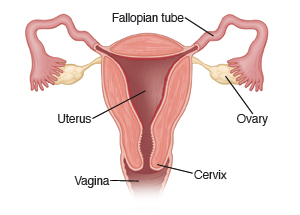You have a vaginal infection called bacterial vaginosis (BV). Both good and bad bacteria are present in a healthy vagina. BV occurs when these bacteria get out of balance. The number of bad bacteria increase. And the number of good bacteria decrease. BV is linked with sexual activity, but it's not a sexually transmitted infection (STI).
BV may or may not cause symptoms. If symptoms do occur, they can include:
-
Thin, gray, milky-white, or sometimes green discharge
-
Unpleasant odor or “fishy” smell
-
Itching, burning, or pain in or around the vagina
It's not known what causes BV, but certain factors can make the problem more likely. These can include:
-
Douching
-
Spermicides
-
Use of antibiotics
-
Change in hormone levels with pregnancy, breastfeeding, or menopause
-
Having sex with a new partner
-
Having sex with more than one partner
BV will sometimes go away on its own. But treatment is often advised. This is because untreated BV can raise the risk of more serious health problems, such as:
-
Pelvic inflammatory disease (PID)
-
Preterm delivery (giving birth to a baby early if you’re pregnant)
-
HIV and some other sexually transmitted infections (STIs)
-
Infection after surgery on the reproductive organs
Home care
General care
-
BV is most often treated with medicines called antibiotics. These may be given as pills or as a vaginal cream. If antibiotics are prescribed, be sure to use them exactly as directed. And complete all of the medicine, even if your symptoms go away.
-
Don't douche or have sex during treatment.
-
If you have sex with a female partner, ask your healthcare provider if she should also be treated.
Prevention
-
Don't douche.
-
Don't have sex. If you do have sex, take steps to lower your risk:
-
Use condoms when having sex.
-
Limit the number of sex partners you have.
-
Follow-up care
Follow up with your healthcare provider, or as advised.
When to get medical advice
Call your healthcare provider right away if any of the following occur:
-
You have a fever of 100.4ºF (38ºC) or higher, or as directed by your healthcare provider.
-
Your symptoms get worse, or they don’t go away within a few days of starting treatment.
-
You have new pain in the lower belly or pelvic region.
-
You have side effects that bother you or a reaction to the pills or cream you’re prescribed.
-
You or any of your sex partners have new symptoms, such as a rash, joint pain, or sores.
Featured in


